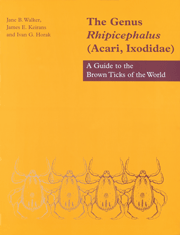Book contents
- Frontmatter
- Contents
- Acknowledgements
- 1 Introduction
- 2 Relationships of the ticks (Ixodida) and definition of the genus Rhipicephalus
- 3 Format for the accounts of individual species
- 4 Glossary
- 5 Rhipicephalus species names of the world
- 6 Rhipicephalus species occurring in the Afrotropical region
- 7 Accounts of individual species occurring in the Afrotropical region. pages 59 to 277
- Accounts of individual species occurring in the Afrotropical region. pages 278 to 490
- 8 Host/parasite list for the Afrotropical Rhipicephalus species
- 9 Rhipicephalus species occurring outside the Afrotropical region
- 10 Accounts of individual species occurring outside the Afrotropical region
- 11 Host/parasite list for the non-Afrotropical Rhipicephalus species
- 12 Species groups based on the immature stages
- 13 The transmission of tick-borne diseases of animals and humans by Rhipicephalus species
- Index
3 - Format for the accounts of individual species
Published online by Cambridge University Press: 05 November 2011
- Frontmatter
- Contents
- Acknowledgements
- 1 Introduction
- 2 Relationships of the ticks (Ixodida) and definition of the genus Rhipicephalus
- 3 Format for the accounts of individual species
- 4 Glossary
- 5 Rhipicephalus species names of the world
- 6 Rhipicephalus species occurring in the Afrotropical region
- 7 Accounts of individual species occurring in the Afrotropical region. pages 59 to 277
- Accounts of individual species occurring in the Afrotropical region. pages 278 to 490
- 8 Host/parasite list for the Afrotropical Rhipicephalus species
- 9 Rhipicephalus species occurring outside the Afrotropical region
- 10 Accounts of individual species occurring outside the Afrotropical region
- 11 Host/parasite list for the non-Afrotropical Rhipicephalus species
- 12 Species groups based on the immature stages
- 13 The transmission of tick-borne diseases of animals and humans by Rhipicephalus species
- Index
Summary
SOURCES OF INFORMATION
The data presented in this book have been obtained from many sources. A major source has been the data files of the United States National Tick Collection (USNTC), whose history has been documented by Durden, Keirans & Oliver (1996). It had its origins early in the century at the Rocky Mountain Laboratory, Hamilton, Montana, hence the prefix ‘RML’ to its collection numbers. In 1983 it was donated to the United States National Museum of Natural History (Smithsonian Institution), where it was curated byJ.E.K. Shortly after H. Hoogstraal died in 1986 his tick collection was also sent to the Smithsonian Institution for incorporation into the USNTC. In 1990 the collection was transferred on long-term enhancement loan from the Smithsonian Institution to the Institute of Arthropodology and Parasitology, Georgia Southern University, where it is still curated by J.E.K., assisted by L. A. Durden. It is the world's largest tick collection, including over 300 types and more than 122 500 individual accessioned collections.
Another important source of information has been material from the collections of The Natural History Museum, London, loaned to us by Anne Baker. These include, amongst many others, the Nuttall Tick Collection (Keirans, 1985) and the Tanzanian Tick Survey Collection (Yeoman & Walker, 1967). Among other sources from which we have obtained data are the Onderstepoort Tick Collection, built up largely by Gertrud Theiler; the Namibian Tick Survey Collection, by courtesy of Heloise Heyne; the collection of the Musée Royal de l'Afrique Centrale, Tervuren, Belgium, including many specimens obtained during colonial times in the Democratic Republic of Congo and now curated by F. Puylaert; and numerous collections from East Africa and South Africa accumulated by J.B.W. and I.G.H. respectively.
- Type
- Chapter
- Information
- The Genus Rhipicephalus (Acari, Ixodidae)A Guide to the Brown Ticks of the World, pp. 5 - 14Publisher: Cambridge University PressPrint publication year: 2000

